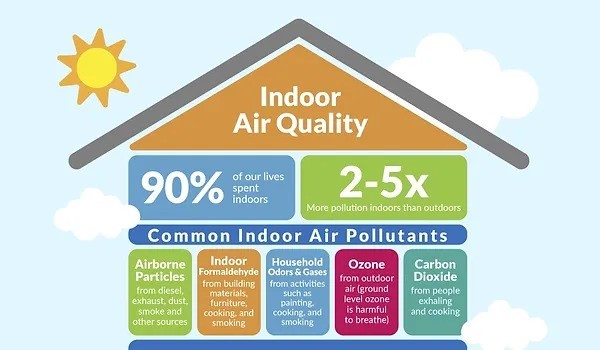Last weekend, we grudgingly received an unwanted guest. This guest brought a lot of dust. The atmosphere was laden with something that looked like harmattan but not quite. Well, we have been debriefed now that we were hit by a sandstorm. As unfortunate as this was, it was another reminder to pay more attention the air we breathe. If you have ever underestimated the impact of polluted air, let the following stats jolt you into the reality out there and why we need to pay extra attention to the air we breathe in.
We spend 90% of our time indoors, and our environment is the largest determinant of our overall health. Humans breathe more than 15,000 liters of air every single day. Indoor Air Quality is 2 to 5 times worse than outdoor air quality. Indoor Air Pollution is ranked as top 5 environmental risks to public health. 50% of illness are caused by aggravated indoor air pollution. While these stats are dire, there always tips that offer relief and protection, hence find a reshare of a few of our popular tips below
Monitoring Devices
People with respiratory conditions like asthma or those who are allergic to airborne substances like dust and pollen have long been aware of the importance of indoor air quality monitoring says Natalie Patton. The technology has been available for a long time, too, mostly in the form of sensors. With the global pandemic caused by COVID-19 everyone from scientists and device
manufacturers to commercial property owners and tenants are taking a closer look at indoor air quality monitoring to see if limiting pollutants can slow the spread of the virus and help buildings become safer places to congregate.
It has been found out that if you are able to control temperature and humidity, volatile organic compounds and especially concentration of CO2s, then you are one step away from providing a safer working environment. Understanding and controlling building ventilation can improve the quality of the air we breathe and reduce the risk of indoor health concerns including prevent the virus that causes COVID-19 from spreading indoors. The only way you can control is to measure the concentration and there are modern monitoring devices and sensors that measure indoor air quality (IAQ) and when CO2s for instance goes beyond it goes beyond the required level then you can ventilate properly to ensure a healthier working environment.
Natural Purifiers
You probably have heard that a way to detox indoor air is to buy a humidify. Well, that is great and all, but in the larger green and health conversation, natural remedies should be the go-to, here are a few.
Airflow is crucial for good indoor air quality. Getting airflow through your house will remove stagnant air and refresh the interior air. Apart from opening up windows to let in fresh air, it is recommended that you run air filter maintenance every 3 months for your Air Conditioners. Beeswax candles or simply the white scentless candles as we know them are also a great way of purifying the air, as these candles burn, they release negative ions in the air. Beeswax candles are 100% natural and not only reduce contaminants in your home, they smell good and create a wonderful ambiance too. These days, due to modernity and a taste for sophistication, we hardly use charcoal, but it will interest you to know that charcoal, old dark and black charcoal, is also a safe way of purifying indoor air, just leave them in the corners of your homes or soak them in buckets of water overnight and voila, they will eat up some of the toxins in the air.
The writer is the Executive director of Yecham Property Consult
& Founder of Ghana Green Building Summit.
Email: [email protected]
Linkedin: Cyril Nii Ayitey Tetteh










